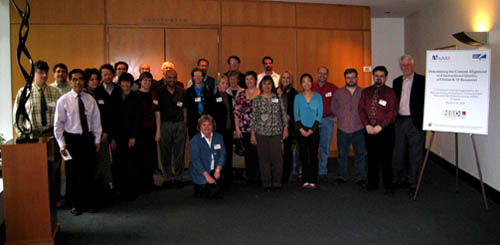Improving Online Resources for K-12 Teachers
Project 2061 recently brought together 30 digital library developers to kick off a two-year effort to provide K-12 science educators with more high-quality online resources. The work is funded by the National Science Foundation’s National Science Digital Library (NSDL) program, which provides organized access to resources and tools that support innovations in teaching and learning at all levels of science, technology, engineering, and mathematics (STEM) education.
Drawing on its knowledge of science standards and previous NSDL partnerships, Project 2061 is training NSDL Pathways personnel to identify resources that are aligned with science content standards and of high instructional quality. The Pathways are NSDL portals that categorize resources for easy access by users interested in the same grade level or science discipline.
At a two-day workshop 9-10 March at AAAS headquarters in Washington, D.C., participants learned how to determine if their resources target the key ideas in science standards. They also examined how likely it is that their resources will contribute to effective teaching and student learning of those key ideas. The ultimate goal is to increase the number of NSDL resources that foster students’ achievement of content standards.
Resources Aligned to Standards
Led by Project 2061’s Ted Willard, participants learned about the development of science content standards, including national standards like Project 2061’s Benchmarks for Science Literacy and the National Science Education Standards. Then they explored Atlas of Science Literacy strand maps, which display the connections among standards as student understanding grows from K to 12. They discussed the essential steps of the alignment process, such as clarifying the ideas in content standards and determining how well a resource addresses the scope and level of sophistication of those ideas.

-
NSDL Pathways specialists with Project 2061 staff at the March workshop
Workshop participants also practiced using Project 2061’s research-based criteria to evaluate resources like real-world phenomena (e.g., objects, systems, events) and representations (e.g., models, diagrams, simulations). They considered factors such as whether the connection between the resource and the learning goal is explicit, the resource’s comprehensibility, and whether the resource is likely to be engaging to students.
“Having the opportunity to talk with AAAS staff about how the learning goals and strand maps were developed was really important in understanding how we should integrate the NSDL Strand Map Service and information about Project 2061 into the Middle School Portal 2: Math & Science Pathways (MSP2) project resources,” said Kim Lightle, principal investigator of the Middle School Portal. “We’ve already started including information about the maps into the MSP2 science Wiki pages.”
Also at the workshop were personnel from the National Science Teachers Association and from six other NSDL Pathway collections: BiosciEdNet (BEN), Chemical Education Digital Library (ChemEd DL), Communities for Physics and Astronomy Digital Resources in Education (ComPADRE), Teachers’ Domain, Science and Math Informal Learning Educators (SMILE), and the Digital Library for Earth System Education (DLESE).
"Human Methods" Here to Stay
In addition to the training, Project 2061 is helping to modify the NSDL Collection System (NCS) so that it combines computer algorithms for suggesting potentially aligned standards with human methods that apply Project 2061's criteria to refine the alignment. This is crucial to the project, according to Francis Molina, principal investigator and Project 2061’s technology director.
“While there was consensus at the workshop about the importance of content standards to the Pathways’ work, there was also concern about just how many different state standards are out there,” explained Molina. “Current technologies, whether based on ‘aligning’ to a common lexicon or natural language processing, can at best only suggest the relationship of a digital resource to a content standard as well as possible translations or crosswalks between standards. So human methods of evaluating resources—like those based on Project 2061’s criteria—are extremely helpful and are here to stay.”
Project 2061 has already used its criteria effectively to evaluate science and mathematics textbooks and to review and select middle school science materials in a previous NSDL project called PRISMS. Now it looks forward to supporting its NSDL Pathways partners in providing ready access to resources that promote the effective teaching and learning of standards.
To build on the March training, Project 2061 will conduct a customized workshop for each NSDL Pathway.
# # #
For more information about Project 2061’s NSDL projects, please contact:
Principal Investigator: Dr. Francis Molina, (202) 326-7002Also in the May/June 2009 issue:




